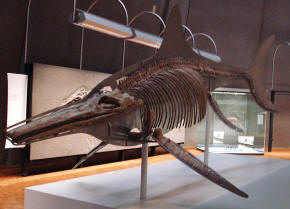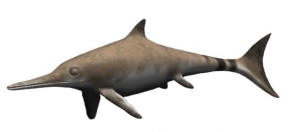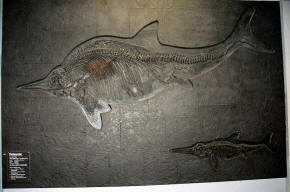Description
Ichthyosaurs averaged 2–4 meters
(6.6–13 ft) in length (although a few were smaller, and some species grew
much larger), with a porpoise-like head and
a long, toothed snout. Built for speed, like modern tuna, some ichthyosaurs
appear also to have been deep divers, like some modern whales. It has been estimated that ichthyosaurs could swim at speeds up to 40
kilometres per hour (25 mph). Similar to modern
cetaceans such as
whales and dolphins, they were air-breathing.
According to weight estimates by
Ryosuke Motani a 2.4 meters (7.9 ft)
Stenopterygius weighed
around 163–168 kilograms (360–370 lb) whilst a 4 meters (13 ft)
Ophthalmosaurus icenicus
weighed 930–950 kilograms (1.03–1.05 short tons).
It has been determined by teeth records that several
sea-dwelling reptiles, including Ichthyosaurus, had a warm-blooded
metabolism similar to that of mammals. They had the ability to generate
endothermic heat to survive in colder habitats.
Although ichthyosaurs looked like
fish, they were not. Ichthyosaurs had fin-like limbs, which were possibly used
for stabilization and directional control, rather than propulsion, which
would have come from the large shark-like tail. The tail was bi-lobed, with
the lower lobe being supported by the caudal vertebral column, which was
"kinked" ventrally to follow the contours of the ventral lobe.
Apart from the obvious similarities
to fish, the ichthyosaurs also shared parallel developmental features with
dolphins,
lamnid sharks, and
tunas. This gave them a
broadly similar appearance, possibly implied similar activity levels
(including thermoregulation), and presumably placed them broadly in a
similar ecological niche.
Reproduction
They were
viviparous (bore live
young). Some adult fossils have even been found
containing
fetuses. Although they
were reptiles and descended from egg-laying ancestors, viviparity is not as
unexpected as it first appears. Air-breathing marine creatures must either
come ashore to lay
eggs, like
turtles and some
sea snakes, or else
give birth to live young in surface waters, like whales and dolphins. Given
their
streamlined bodies,
heavily adapted for fast swimming, it would have been difficult for
ichthyosaurs to move far enough on land to lay eggs.
Feeding
For their food, many of the
fish-shaped ichthyosaurs relied heavily on ancient
cephalopod kin of
squids called
belemnites. Some early
ichthyosaurs had teeth adapted for crushing
shellfish. They also
most likely fed on fish, and a few of the larger species had heavy jaws and
teeth that indicated they fed on smaller reptiles. Ichthyosaurs ranged so
widely in size, and survived for so long, that they are likely to have had a
wide range of prey. Typical ichthyosaurs have very large eyes, protected
within a
bony ring, suggesting
that they may have hunted at night.
Return to the
Old Earth Ministries Online Dinosaur
Curriculum homepage.



